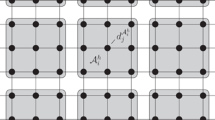Abstract
A variational multiscale large-eddy simulation (VMS-LES) code, named MISTRAL, has been developed based upon the finite element method (FEM) for accurate and practical computation of geometrically complicated turbulent flow problems. The numerical strategy of the FEM-based VMS-LES is explained, especially focusing on the double-scale approximation for velocity and pressure in the incompressible Navier-Stokes equations, a pressure stabilization technique and a multiscale turbulence modeling. A unique technique is also employed in the time integration to realize an efficient inversion of the multiscale mass matrix and to form the multiscale pressure Poisson equation used in the approximate projection method for divergence-free constraint of velocity. As a numerical demonstration, a 2D driven cavity flow problem has been solved with the MISTRAL code in a wide range of Reynolds number (Re=1000 to 50000). The results are compared with reference data to quantitatively estimate the accuracy (magnitude of errors in terms of L 2 norms) of the proposed VMS-LES method.
Similar content being viewed by others
References
Hughes, T.J.R., Mazzei, L., Jansen, K.E.: Large eddy simulation and the variational multiscale method. Comput. Vis. Sci. 3, 47–59 (2000)
Collis, S.: Monitoring unresolved scales in multiscale turbulence modeling. Phys. Fluids 13, 1800–1806 (2001)
Hughes, T.J.R., Mazzei, L., Oberai, A.A.: The multiscale formulation of large eddy simulation: Decay of homogeneous isotropic turbulence. Phys. Fluids 13, 505–512 (2001)
Hughes, T.J.R., Oberai, A.A., Mazzei, L.: Large eddy simulation of turbulent channel flows by the variational multiscale method. Phys. Fluids 13, 1784–1799 (2001)
Erturk, E., Gökçöl, C.: Fourth-order compact formulation of Navier–Stokes equations and driven cavity flow at high Reynolds numbers. Int. J. Numer. Meth. Fluids. 50, 421–436 (2006)
Hughes, T.J.R., Franca, L.P.: A new finite element formulation for computational fluid dynamics: VII The Stokes problem with various well-posed boundary conditions: Symmetric formulations that converge for all velocity/pressure spaces. Comput. Methods Appl. Mech. Eng. 65, 85–96 (1987)
Silvester, D.J., Kechkar, N.: Stabilised bilinear-constant velocity-pressure finite elements for the conjugate gradient solution of the Stokes problem. Comput. Methods Appl. Mech. Eng. 79, 71–86 (1990)
Eguchi, Y.: A new positive-definite regularization of incompressible Navier-Stokes equations discretized with Q1/P0 finite element. Int. J. Numer. Meth. Fluids 41, 881–904 (2003)
Brooks, A.N., Hughes, T.J.R.: Streamline upwind/Petrov-Galerkin formulations for convection dominated flows with particular emphasis on the incompressible Navier-Stokes equations. Comput. Methods Appl. Mech. Eng. 32, 199–259 (1982)
Eguchi, Y.: On streamline diffusion arising in Galerkin FEM with predictor/multi-corrector time integration. Int. J. Numer. Meth. Fluids 39, 1037–1052 (2002)
Eguchi, Y.: Practical techniques for a 3-D FEM analysis of incompressible fluid flow contained with slip walls and a downstream tube bundle. Int. J. Numer. Meth. Fluids 37, 279–295 (2001)
Almgren, A.S., Bell, J.B., Crutchfield, W.: Approximate projection methods: Part 1. inviscid analysis. SIAM J. Sci. Comput. 22, 1139–1159 (2000)
Stevens, D.E., Chan, S.T., Gresho, P.M.: An approximate projection method for incompressible flow. Int. J. Numer. Meth. Fluids 40, 1303–1325 (2002)
Kraichnan, R.H.: Eddy viscosity in two and three dimensions. J. Atmos. Sci. 33, 1521–1536 (1976)
Sukoriansky, S., Chekhlov, A., Orszag, S.A., Galperin, B., Staroselsky, I.: Large eddy simulation of two-dimensional isotropic turbulence. J. Sci. Comput. 11, 13–45 (1996)
Su, W.-D., Zhao, H., Cai, Q.-D., Xiong, A.-K., Wu, J.-Z.: A diagnosis of linear eddy-viscosity in turbulence modeling. Phys. Fluids 14, 1284–1287 (2002)
Hatayama, S.: Parallel computations of incompressible viscous flow in a lid-driven square cavity and program performance on the NWT computer system. Technical Report Of National Aerospace Laboratory TR-1363T (NALTR0001363T). (As of Nov. 2007, the report is available at http://send.chofu.jaxa.jp/send/jpn/dlpdf.php3/naltr0001363t.pdf?id=NALTR0001363T) (1998)
Author information
Authors and Affiliations
Corresponding author
Rights and permissions
About this article
Cite this article
Eguchi, Y. Development of a Variational Multiscale Large-Eddy Simulation Code ‘MISTRAL’ Using Double-Scale Finite Elements. J Sci Comput 43, 433–453 (2010). https://doi.org/10.1007/s10915-008-9226-4
Received:
Revised:
Accepted:
Published:
Issue Date:
DOI: https://doi.org/10.1007/s10915-008-9226-4




